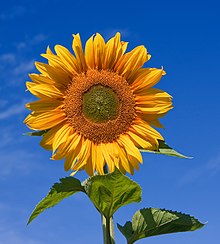Helianthus

Helianthus (/ˌhiːliˈænθəs/)[3] is a genus comprising about 70 species of annual and perennial flowering plants in the daisy family Asteraceae.[4][5] Except for three South American species, the species of Helianthus are native to North America and Central America. The common names “sunflower” and “common sunflower” typically refer to the popular annual species Helianthus annuus, whose round flower heads in combination with the ligules look like the sun.[6] This and other species, notably Jerusalem artichoke (H. tuberosus), are cultivated in temperate regions and some tropical regions as food crops for humans, cattle, and poultry, and as ornamental plants.[7] The species H. annuus typically grows during the summer and into early fall, with the peak growth season being mid-summer.[8]
Several perennial Helianthus species are grown in gardens, but have a tendency to spread rapidly and can become aggressive. The whorled sunflower, Helianthus verticillatus, was listed as an endangered species in 2014 when the U.S. Fish and Wildlife Service issued a final rule protecting it under the Endangered Species Act. The primary threats are industrial forestry and pine plantations in Alabama, Georgia, and Tennessee. They grow to 1.8 m (6 ft) and are primarily found in woodlands, adjacent to creeks and moist, prairie-like areas.[9]
Sunflowers are thought to be domesticated 3000–5000 years ago by Native Americans who would use them primarily as a source for edible seeds. They were then introduced to Europe in the early 16th century and made their way to Russia. In Russia, where oilseed cultivators were located, these flowers were developed and grown on an industrial scale. Russia then reintroduced this oilseed cultivation process to North America in the mid-20th century; North America began their commercial era of sunflower production and breeding.[12] New breeds of the Helianthus spp. began to become more prominent in new geographical areas.
This species’ geographical history accounts for its evolutionary history, with its levels of genetic variation across its gene pool increasing as new hybrids are created both for commercial use and in the wild. Subsequent to this, sunflower species are also experiencing the bottle neck effect in their gene pool as a result of selective breeding for industrial use.[12]
